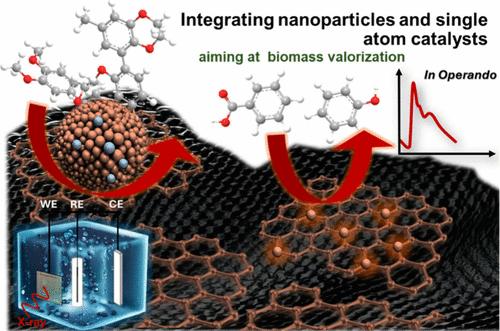Electrochemical Biomass Depolymerization: Will Complex Catalysts Trigger High Product Selectivity?
IF 7
2区 材料科学
Q2 CHEMISTRY, PHYSICAL
引用次数: 0
Abstract
In this perspective, we propose a conversation toward the future of sustainable chemical industry through the lens of electrochemical biomass depolymerization. Despite the chemical industry’s extensive history and established processes, the discovery of new materials remains crucial. This perspective highlights the limitations of current bulk and thin-film electrocatalysts for biomass depolymerization, which have not matched the advancements seen in electrochemical CO2 reduction. We propose a paradigm shift toward the use of complex catalysts, including transition metal borides (TMBs), transition metal nitrides (TMNs), transition metal carbides (TMCs), MXenes, transition metal phosphides (TMPs), nanoparticles, and single atom catalysts (SACs), to enhance product selectivity, i.e., Faradaic efficiency, in biomass depolymerization. By leveraging the dynamic structural features and superior catalytic properties observed in electrocatalysts for CO2 reduction, we aim to achieve high selectivity for specific bond cleavages in biobased feedstocks. This shift promises to unlock new pathways in biomass valorization, underscoring the ongoing need for innovative materials to drive sustainable technologies. The development of such catalysts not only advances our scientific understanding but also holds the potential to shape a truly green future, reaffirming the vital role of solid-state chemistry in the 21st century.

电化学生物质解聚:复杂催化剂能否引发高产品选择性?
在这一视角下,我们从电化学生物质解聚的角度出发,为可持续化学工业的未来展开对话。尽管化学工业有着悠久的历史和成熟的工艺,但新材料的发现仍然至关重要。这一视角凸显了目前用于生物质解聚的块状和薄膜电催化剂的局限性,它们与电化学二氧化碳还原技术的进步并不匹配。我们提出了使用复合催化剂的模式转变,包括过渡金属硼化物 (TMB)、过渡金属氮化物 (TMN)、过渡金属碳化物 (TMC)、MXenes、过渡金属磷化物 (TMP)、纳米颗粒和单原子催化剂 (SAC),以提高生物质解聚过程中的产物选择性,即法拉第效率。通过利用在二氧化碳还原电催化剂中观察到的动态结构特征和优异催化性能,我们的目标是实现生物基原料中特定键裂解的高选择性。这种转变有望为生物质的价值化开辟新的途径,凸显了对创新材料的持续需求,以推动可持续技术的发展。这种催化剂的开发不仅能促进我们对科学的理解,而且有可能塑造一个真正绿色的未来,再次证明了固态化学在 21 世纪的重要作用。
本文章由计算机程序翻译,如有差异,请以英文原文为准。
求助全文
约1分钟内获得全文
求助全文
来源期刊

Chemistry of Materials
工程技术-材料科学:综合
CiteScore
14.10
自引率
5.80%
发文量
929
审稿时长
1.5 months
期刊介绍:
The journal Chemistry of Materials focuses on publishing original research at the intersection of materials science and chemistry. The studies published in the journal involve chemistry as a prominent component and explore topics such as the design, synthesis, characterization, processing, understanding, and application of functional or potentially functional materials. The journal covers various areas of interest, including inorganic and organic solid-state chemistry, nanomaterials, biomaterials, thin films and polymers, and composite/hybrid materials. The journal particularly seeks papers that highlight the creation or development of innovative materials with novel optical, electrical, magnetic, catalytic, or mechanical properties. It is essential that manuscripts on these topics have a primary focus on the chemistry of materials and represent a significant advancement compared to prior research. Before external reviews are sought, submitted manuscripts undergo a review process by a minimum of two editors to ensure their appropriateness for the journal and the presence of sufficient evidence of a significant advance that will be of broad interest to the materials chemistry community.
 求助内容:
求助内容: 应助结果提醒方式:
应助结果提醒方式:


